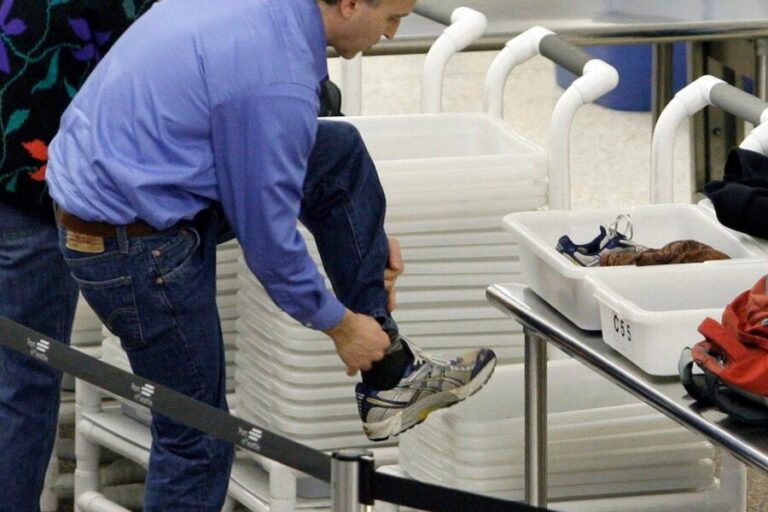In a long-awaited policy shift, U.S. travelers are now permitted to keep their shoes on at airport security checkpoints, marking the end of a nearly two-decade-long practice that many considered one of the most inconvenient parts of air travel.
Homeland Security Secretary Kristi Noem formally announced the change on Tuesday at a press conference held at Ronald Reagan Washington National Airport in Washington, D.C. The new rule applies nationwide — including at major transit hubs such as Chicago’s O’Hare International Airport — and extends to all travelers, even those without TSA PreCheck.
Why the Change?
The shoe removal rule had been in place since 2006, a reaction to the 2001 attempted shoe bombing by Richard Reid. The Transportation Security Administration (TSA) introduced the measure as a way to screen for explosive devices that might be concealed in footwear. Over the years, it became one of the most visible aspects of U.S. airport security.
However, Secretary Noem emphasized that security screening has dramatically evolved.
“Since that policy was put in place, our security technology has changed dramatically. It’s evolved. TSA has changed,” Noem said. “We have a multilayered, whole-of-government approach now to security and to the environment that people anticipate and experience when they come into an airport.”
How Travelers Reacted at O’Hare
At Chicago’s O’Hare — one of the busiest airports in the world — reactions ranged from relief to confusion.
Ruzha Dimova, who was dropping off her children for an international flight, welcomed the update.
This is good. Even if you’re traveling with kids, this is a really good idea, because it takes so long to take them off and put them back on,” she said.
Another traveler pointed out the struggle older adults and first-time flyers face.
Sometimes it’s harder for older people or younger, like first-time travelers like my son,” she explained.
Despite the announcement, many passengers were still seen removing their shoes on Tuesday, likely due to habit or lack of awareness. Outdated TSA instructional videos continued to play in security lines, adding to the confusion.
“I say it’s not a problem for me before or now,” one man said. “Maybe it’s faster right now, you know?”
Will This Make Travel Faster?
Cutting down on bottlenecks at TSA checkpoints was one of the primary motivations behind the policy change. Secretary Noem stated that the department hopes to reduce congestion, particularly during peak travel seasons.
Yet, not all travelers were enthusiastic. One frequent flyer questioned the value of his TSA PreCheck membership, which had previously allowed him to keep his shoes on.
So I paid for TSA for nothing, TSA PreCheck? I need my money back,” the man joked, expressing mixed feelings.
Exceptions Still Apply
While the policy shift is widespread, it’s not without conditions. The Department of Homeland Security clarified that passengers may still be asked to remove their shoes if they trigger additional screening protocols or present specific risk factors.
And although the shoe removal requirement has ended, travelers must still comply with other regulations, including presenting a REAL ID or passport to pass through security.
What It Means Going Forward
The end of mandatory shoe removal marks a significant milestone in post-9/11 aviation security policy. It also reflects how far security infrastructure and threat detection technology have come in the past 20 years.
This update is expected to improve the flow of passengers at airports across the country — a welcome relief for families, seniors, and travelers with physical limitations.
Still, the TSA advises passengers to remain aware of evolving security procedures and stay informed through official channels.
FAQs:
- Do I still need TSA PreCheck to keep my shoes on?
No. As of July 8, 2025, all passengers — regardless of TSA PreCheck status — can keep their shoes on unless flagged for additional screening. - Is this change effective at all airports?
Yes, the policy is nationwide, including at Chicago’s O’Hare, LAX, JFK, Atlanta, and more. - Are there any exceptions?
Yes. If you are selected for additional screening or exhibit signs of a security risk, TSA agents may still ask you to remove your shoes. - Do I still need a REAL ID or passport?
Yes. The ID requirements for air travel have not changed. You’ll still need a REAL ID or a valid passport to proceed through TSA checkpoints.
Summary:
The federal government has officially retired the requirement to remove shoes at airport security — a long-standing measure that defined American air travel post-9/11. Backed by advancements in screening technology, the shift is designed to streamline the passenger experience without compromising safety. While some confusion remains, especially among uninformed travelers, the change is expected to ease travel, particularly for families and seniors, at busy hubs like O’Hare and beyond.
